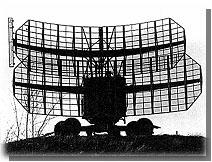Low-frequency radars may be used to overcome "Stealth" technology
"Low-frequency radars, destined to become the base element of any detection system against LO aircraft and guided missiles, enjoy increasing confidence of military hardware developers, as computing capabilities of modern radars and sophistication of computing algorithms are rapidly growing and allow to identify even the smallest characteristics of aircraft designs using "Stealth" technology.
A recently published article from Aviation Week & Space Technology, based on the interview with a US Navy pilot, who participated in the planning of strikes against Iraqi air defense during the early stages of the operation Desert Storm, indicates that there is "nothing invisible in the radar frequency range below 2GHz" [reverse translation from Russian] and with a well-designed low-frequency radar it is possible to "see even a dragonfly at a great distance" [reverse translation from Russian].
According to another high-ranking US Navy official, following an evaluation of current radar systems, used by the US in combat condition today, it became clear that the approach selected for the development of some of the earliest radar was quite effective. "If it would be possible to filter out the noise, then long-wave, low-frequency radars will be capable of detecting a variety of objects [reverse translation from Russian].
In particular, former defense partners of USSR and China have a considerable quantities of older low-frequency radars still in service. These radars use very basic technology, however their performance can be drastically improved through the application of latest computer microprocessor technology. Well-known modifications of such radars include the Iraqi "Tiger Song" radar, Chinese "Nantsin" radar and a number of older Soviet-made long-range radars.
According to the official spokesman for the US Navy, today these countries invite specialists in the area of microprocessors, who will concentrate their efforts on creating computing algorithms for noise filtration. A possibility appeared of using these modified old radars in networks, maximizing the effectiveness in combat situations. "Now it is known that certain type of radar signals present a threat, even though in the past such types of signals were not considered dangerous. Characteristics of a combat zone have drastically changed" [reverse translation from Russian].
According to the same US Navy representative, " a positive side of such low-frequency radar systems is their large size, making them vulnerable in the area of combat, even though it is extremely difficult to jam such radars. These type of radars are difficult to transport. Attempts to introduce rapid changes in a network of low-frequency radars may damage the network's performance even without the "help" of enemy aviation" [reverse translation from Russian]. A negative side of low-frequency radar networks is that American military planners may not be aware of all components of such air defenses, if they do know the specifics of communications among the individual elements of early detection networks.
However, in industrialized countries low-frequency bands are normally used by a wide variety of communications systems, navigation equipment and television. Intensive use of low-frequency bands by secondary systems makes it difficult to find bandwidths wide enough for military planners to use low-frequency radars.
Soviet-made Bar Lock long-range radar |
Soviet-built low-frequency "Bar Lock" and "Spoonrest" radars were used for detecting targets at great distances. These radars operated in the UHF and L-band frequency ranges when it was possible to make use the half-wave resonance effect. This effect can be observed when the length of an aircraft or a cruise missile roughly corresponds to the half of the wavelength, thus creating phase-coherent reflections from the terminal points of the target. Dipole reflector, developed during the Second World War, used this effect to jam radars of that era. Metallic film, cut into strips of the length corresponding to half of the wavelength, resonate with the incoming radar signal, creating an illusion of a large target. Using the resonance effect it is relatively easy to detect even the most advanced LO aircraft, cruise missiles and ballistic missiles.
On the other hand, the width of low-frequency bands makes it difficult to detect a target with sufficient accuracy (in the range of 30-50m), to provide targeting information to SAMs or AAAs. Thus LO aircraft and missiles at the moment continue to enjoy the advantages of stealth."
(my translation of RNTI ITAR-TASS article from 04-05-99)
